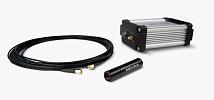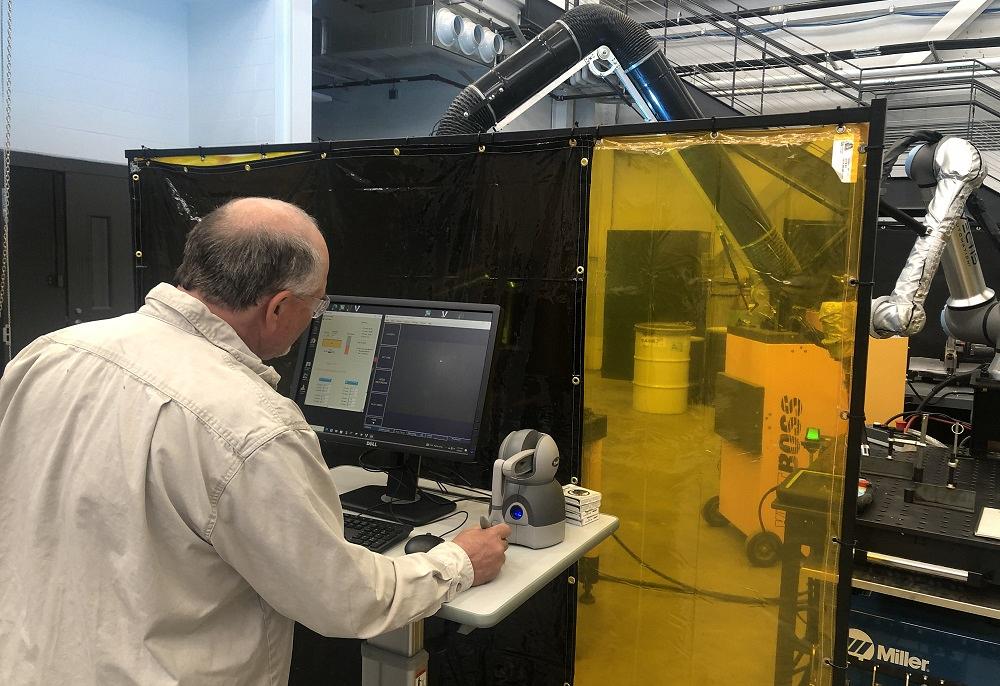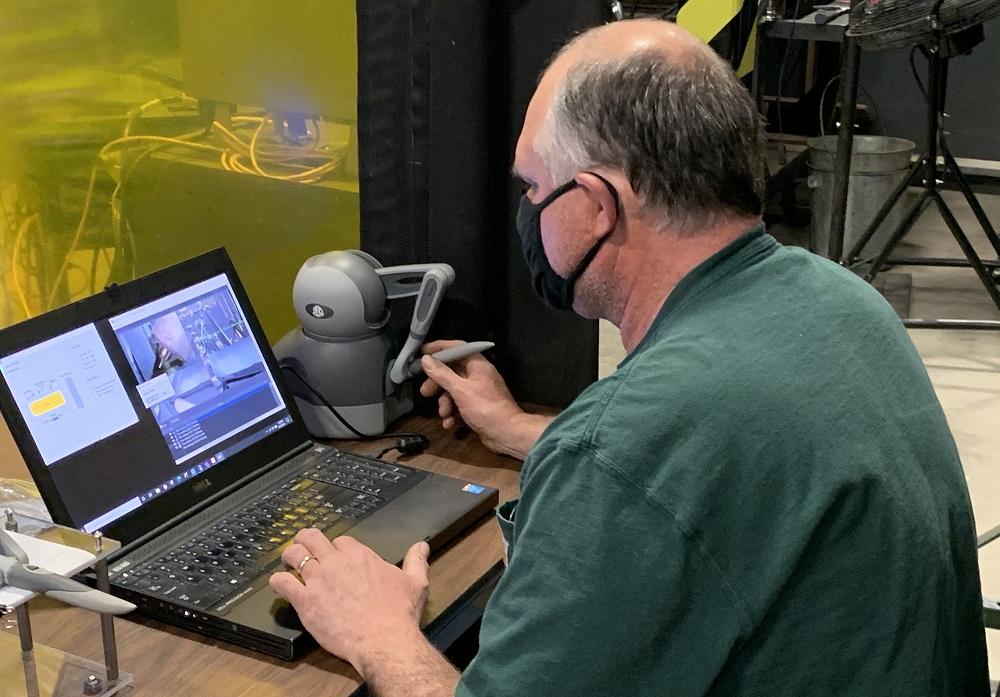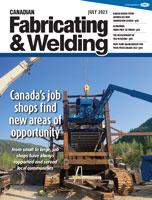Associate Editor
- FMA
- The Fabricator
- FABTECH
- Canadian Metalworking
The development of tele-welding
New tech enables remote execution of critical manufacturing processes like welding
- By Lindsay Luminoso
- August 7, 2023
- Article
- Welding
What if I told you that you can weld the inside of a ship hull—or anything really—without leaving the comforts of your home office? You may be thinking, ‘Yeah right,’ but it’s true! EWI, a non-profit engineering and technology organization, has spent the past few years partnering with government and industry to help bring this concept to reality.
“This project began in 2018 as a joint research project in collaboration with the National Shipbuilding Research Program (NSRP),” said Connie LaMorte, principal engineer, EWI, Columbus, Ohio. “We were looking at ways to help shipyards keep their skilled workers from retiring too early. Shipbuilding and, particularly, welding can be physically taxing, especially as there are many instances where welders are required to crawl into odd spaces or on scaffolding. After decades of doing this, they just can’t get into these positions anymore. We asked ourselves how we can get welders to perform work more easily. This was the impetus for developing a way to remotely execute critical manufacturing processes like welding, machining, and inspecting across long distances.”
LaMorte noted that the project kicked off prior to COVID shutdowns. However, things accelerated when the pandemic made clear that people with manual jobs like welders and other manufacturing techs—in contrast to many other workers—were unable to work from home when needed.
“At the time, we had been trying to find a way to enable people to weld more easily and to be more involved in the industry,” said LaMorte. “We're always trying to find ways to get the next generation interested in welding. When all the pandemic-related factors hit at the same time, it emphasized why we proposed tele-welding to NSRP.”
New Technology
Inspired by the success of the da Vinci medical robot, the team worked to develop a concept where a welding device could be driven by an operator who was not physically in the weld space. This concept is known as tele-welding or cloud-based welding.
“Tele-welding gives welders the benefit of manoeuvring the mechanical system within the comfort and safety of a remote location,” said LaMorte. “And while we were focused on welding at first, we were later able to apply tele-manufacturing to other challenging applications like gouging or grinding, where removing the operator from the work zone can add a level of protection.”
Tele-welding also makes sense for high-mix/low-volume or job shop-style production, especially in situations where shops don’t have the time or personnel to program a robot every time a new part comes in.
EWI spent more than a year investigating different ways to bring tele-welding to life. At first, it looked at existing welding training systems for inspiration. There was one idea to use a welding torch and put targets on [the torch] with an overhead camera to track movements. Another option was to use data gloves with a fake or dummy torch and monitored by an overhead camera.
Other controller options included a joystick, hand-held stylus, and a PC mouse. EWI spent a great deal of time investigating how to effectively and accurately transfer the hand movement from the operator to the robot performing the welding. It was important to understand how an operator expects the hand movements to function and operate on the other end of the process.
“In the end, using a hand-held stylus device was one of the easiest options and made best use of what a seasoned welding operator would already be familiar with,” said LaMorte. “This device allowed the operator to move in the way he wanted. And he could still accomplish the welding movement by watching what was happening on the screen, which showed the robot moving in response to his hand moving.”
The stylus device, which was adopted first, provides the most realistic experience. However, it does have some limitations, including a finite area of movement. For example, if the robot is expected to perform 2 ft. of welding, the stylus has only an 8 to 10 in. range, so the stylus to robot motion method had to be adjusted for that.
“The operator has to adjust to make sure that the motion still occurs in a way with which it is bounded by the stylus device,” said LaMorte. “The type of camera that is used for the application and where it’s stationed were significant considerations. We initially thought everyone would want lots of cameras. It seemed good in theory, but in practice it was too much information for the operator, who was used to a view through the weld helmet. While we learned that operators are particular about how they want to see the welding environment, they do not want to have to select between cameras. When someone is welding, they are most interested in the view of the weld pool and the arc. We needed to adjust for the way a welder actually views the weld site.”
Real-world Applications
As an applied R&D organization, EWI is involved with bringing ideas to fruition.
“We work with partners and integrators to move technology to the next level and bring concepts to a level where they are ready to be commercialized,” said LaMorte.
Of all the tele-applications, welding is the one that EWI has spent a majority of its focus. The tele-welding application was at the alpha prototyping stage in 2021, when it was demonstrated in the shipyard environment and used by shipyard welders. It’s now in the second of four stages while EWI works to complete a beta prototype for installation at the shipyards.
“The beta system will be set up in shipyards for them to use it and abuse it,” said LaMorte. “The next steps are full implementation and then commercialization. At the same time the shipyards are working to implement the tele-technology into their production, we also try to work with existing commercial equipment partners who can commercialize it.”
While tele-welding is EWI’s first tele-application to progress to stage two, it is not the only application being developed. LaMorte added that tele-grinding and tele-inspection also are areas that the company is hoping to find partners to advance and commercialize the technology.
A Changing Workforce
“We're in the middle of Industry 4.0,” said LaMorte. “I think with Industry 5.0 we are going to see a major shift in the workforce in that the majority of the jobs will be able to be performed remotely. Also, with the acceleration of space exploration, we will need to be able to perform tasks either from the Earth or from the Space Station. But also, for general manufacturing in the world, working with something where you can basically call in when you're ready really changes our ability to produce and to be able to increase how we produce things.”
Many companies have already started to shift the way they work. Many people, especially during the pandemic, moved further away from their employers. Unfortunately, this was particularly challenging for industries that required their workers to be in the shop day in and day out. Tele-manufacturing will enable people to be able to work where they live and work where they want. It will provide a level of flexibility in the shop that hasn’t been available before.
“The other advantage is that in this global economy, there will almost always be somebody who will be ready to log on and start the work, whether they're living next to the plant or if they're living in another country,” said LaMorte. “This may change the shift work and workflow of how projects get done. It’s a new way of thinking about manufacturing.
“In order to make tele-welding work, we use the information from the experts who've been welding on the shop floor for decades,” said LaMorte. “We need to make [this new method of tele-welding] as intuitive as possible, and then eventually, it will require a different level of training for those who are new to the trade. It’s a different way of perceiving the environment than they're typically used to. It's no longer tangible in a local way, it's tangible in a remote way.”
Associate Editor Lindsay Luminoso can be reached at lluminoso@canadianfabweld.com.
EWI, ewi.org
About the Author

Lindsay Luminoso
1154 Warden Avenue
Toronto, M1R 0A1 Canada
Lindsay Luminoso, associate editor, contributes to both Canadian Metalworking and Canadian Fabricating & Welding. She worked as an associate editor/web editor, at Canadian Metalworking from 2014-2016 and was most recently an associate editor at Design Engineering.
Luminoso has a bachelor of arts from Carleton University, a bachelor of education from Ottawa University, and a graduate certificate in book, magazine, and digital publishing from Centennial College.
subscribe now


Keep up to date with the latest news, events, and technology for all things metal from our pair of monthly magazines written specifically for Canadian manufacturers!
Start Your Free Subscription- Trending Articles
Aluminum MIG welding wire upgraded with a proprietary and patented surface treatment technology

Hypertherm Associates partners with Rapyuta Robotics

Protected and productive: welding helmet tech

HGG Profiling Equipment BV names Western Canada area sales manager

Compact weld camera monitors TIG, plasma processes

- Industry Events
Automate 2024
- May 6 - 9, 2024
- Chicago, IL
ANCA Open House
- May 7 - 8, 2024
- Wixom, MI
17th annual Joint Open House
- May 8 - 9, 2024
- Oakville and Mississauga, ON Canada
MME Saskatoon
- May 28, 2024
- Saskatoon, SK Canada
CME's Health & Safety Symposium for Manufacturers
- May 29, 2024
- Mississauga, ON Canada


















